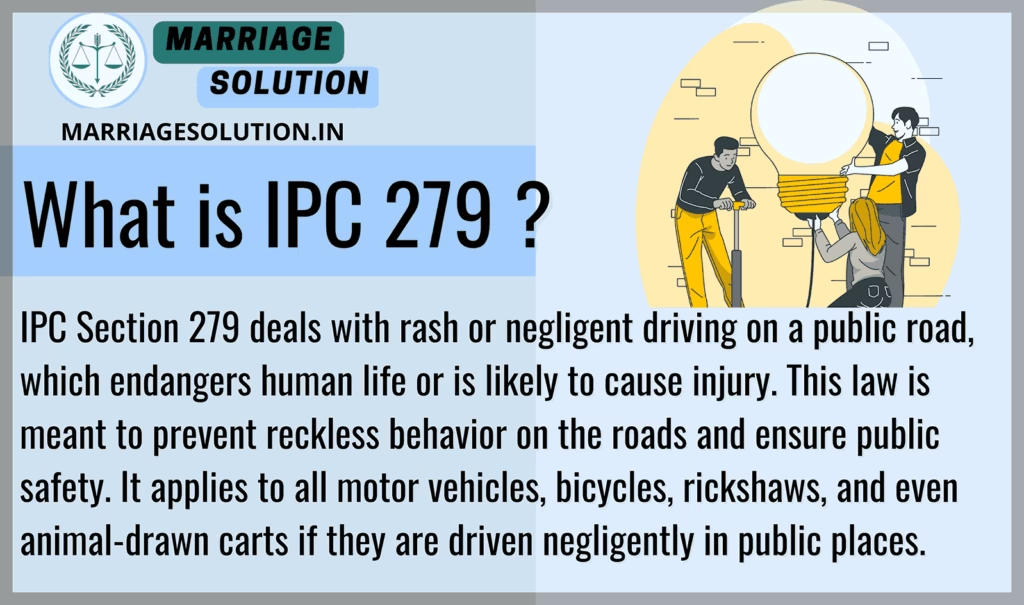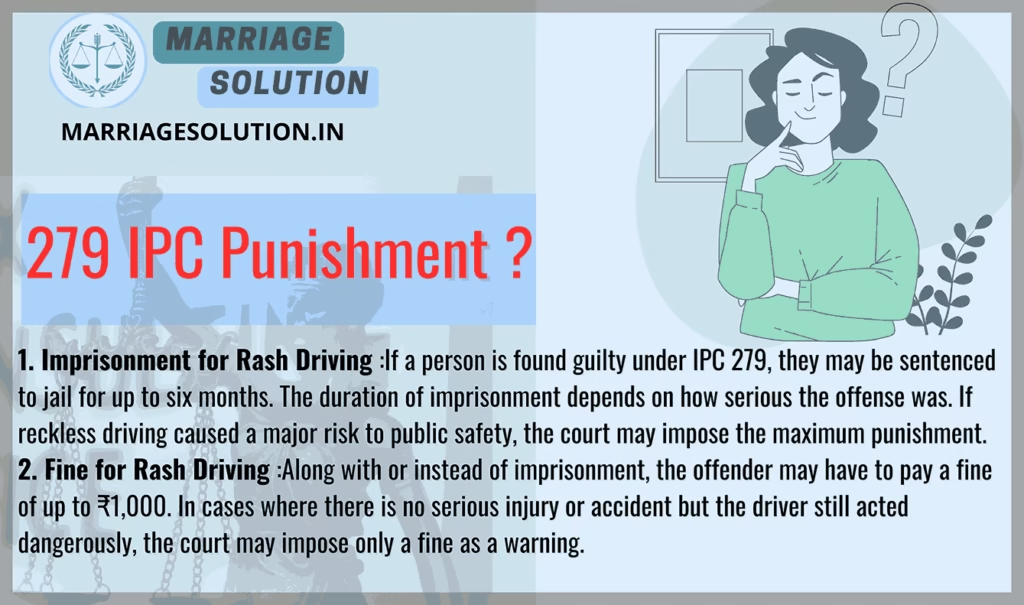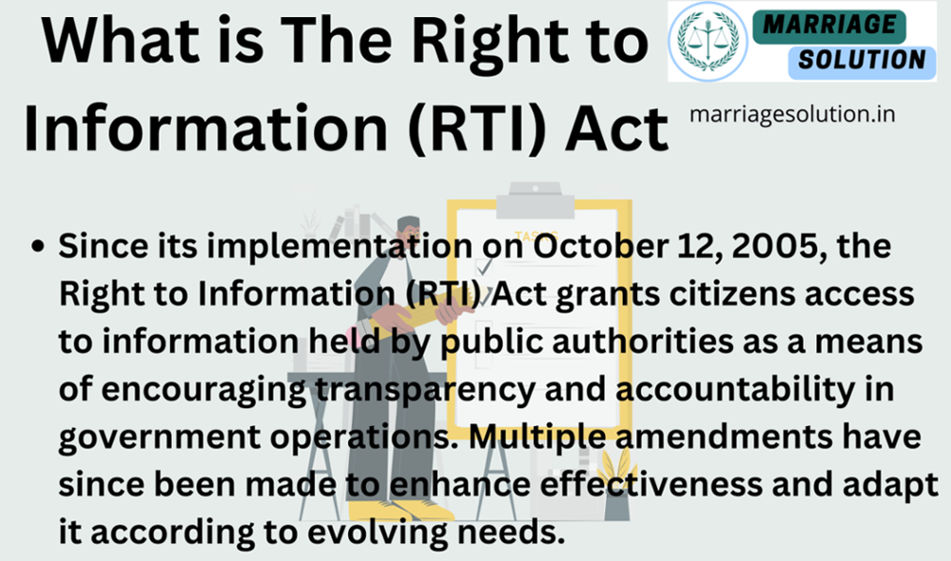Introduction of IPC 279
Indian Penal Code (IPC) Section 279 deals with rash and negligent driving or riding on a public road. This section aims to prevent reckless driving that could endanger human life or cause injury to others. Road safety is a major concern, and careless driving can lead to serious accidents, injuries, and even loss of life.
- Introduction of IPC 279
- What is IPC Section 279?
- Section 279 IPC in Simple Points
- Section 279 IPC Overview
- IPC 279: Rash Driving or Riding on a Public Way
- 10 Key Points of IPC 279
- 1. Definition of Rash Driving
- 2. Applicability on All Vehicles
- 3. Public Road or Way Requirement
- 4. Endangering Human Life or Safety
- 5. Intention is Not Necessary
- 6. Punishment Under IPC 279
- 7. Bailable and Cognizable Offense
- 8. Relationship with Other IPC Sections
- 9. Role of Traffic Police and Legal Action
- 10. Importance of Safe Driving and Awareness
- Example 1: Rash Driving in a School Zone
- Example 2: Over-Speeding on a Crowded Market Road
- Section 279 IPC case laws
- 279 IPC Punishment
- 279 IPC Bailable or non bailable
- Section 279 IPC in short information
- IPC Section 279 FAQs
- If you need support with court proceedings or any other legal matters, don’t hesitate to reach out for assistance.
What is IPC Section 279?
IPC Section 279 deals with rash or negligent driving on a public road, which endangers human life or is likely to cause injury. This law is meant to prevent reckless behavior on the roads and ensure public safety. It applies to all motor vehicles, bicycles, rickshaws, and even animal-drawn carts if they are driven negligently in public places.

Section 279 IPC in Simple Points
1. Rash Driving Means Driving Without Care for Safety
Rash driving means operating a vehicle in a way that is careless, fast, or reckless, without thinking about the safety of others. It includes over-speeding, dangerous overtaking, sudden braking, ignoring traffic signals, and not following road rules. A person does not need to cause an accident to be punished under IPC 279. If their driving creates a high risk of injury or death, it is enough for legal action. For example, if a motorcyclist speeds through a crowded market without hitting anyone, they can still be charged under this section because they put people at risk. The focus of IPC 279 is not only on accidents but also on preventing dangerous situations. This law helps control reckless drivers before they cause serious harm. The police and traffic authorities have the power to take immediate action against those who drive irresponsibly on public roads.
2. The Law Applies to All Vehicles on Public Roads
IPC 279 is not limited to cars or motorcycles; it applies to all types of vehicles, including buses, trucks, bicycles, rickshaws, and even animal-drawn carts. The key condition is that the vehicle must be on a public road where other people are present. If someone drives dangerously inside a private property, farm, or closed area, IPC 279 does not apply. For example, if a cyclist rides at high speed through a pedestrian crossing, creating a risk of hitting people, they can be charged under this law. Similarly, a bullock cart driver who moves recklessly on a busy street can also be held responsible. This law ensures that every person using a public road is responsible for their actions. It aims to create discipline among drivers and riders to prevent unnecessary accidents and harm to the public.
3. Punishment Under IPC 279 is Based on the Risk Created
The punishment under IPC 279 depends on the level of danger created by reckless driving. The offender may face imprisonment of up to six months, a fine of up to ₹1,000, or both. The police and courts decide the punishment based on how serious the offense is. If a person drives at high speed in a school zone, ignoring safety rules, they may receive both jail time and a fine. However, if someone accidentally drives carelessly but immediately corrects their behavior, the punishment may be less severe. The goal of the punishment is not only to penalize the offender but also to warn other drivers about the dangers of reckless driving. In many cases, traffic police issue challans (fines) on the spot for minor offenses. However, if rash driving results in an accident or serious injury, additional IPC sections (like IPC 337 and IPC 338) may be added for stricter punishment.
4. IPC 279 is a Cognizable and Bailable Offense
IPC 279 is classified as a cognizable offense, meaning the police have the authority to arrest the offender without prior permission from a magistrate. This helps in taking immediate action against reckless drivers who pose a risk to public safety. However, it is also a bailable offense, meaning the accused person can apply for bail and may not have to stay in custody for long. This classification ensures that serious offenders are stopped immediately, but those who commit minor mistakes are not unnecessarily detained. For example, if a driver is caught speeding dangerously and refuses to stop, the police can arrest them on the spot. However, if the offense was not extreme, the person can be released on bail the same day. This balance helps in controlling reckless driving while preventing harsh punishments for minor offenses.
5. Connection with Other IPC Sections and Traffic Laws
IPC 279 is often applied along with other legal provisions if the rash driving results in harm to others. If the offense causes a minor injury, IPC 337 (causing hurt by rash act) is also applied. If it results in serious injury, IPC 338 (causing grievous hurt by rash act) is added. If a person dies due to reckless driving, the offender is charged under IPC 304A (causing death by negligence), which carries a harsher punishment. Apart from the IPC, India’s Motor Vehicles Act, 1988 also has strict rules for traffic violations, such as license suspension, higher fines, and vehicle seizure. For example, if a truck driver loses control due to over-speeding and crashes into a shop, they may be charged under IPC 279, IPC 338 (serious injury), and IPC 427 (mischief causing damage to property). This shows that reckless driving is taken very seriously, and multiple laws are used to ensure road safety.
Section 279 IPC Overview
IPC 279: Rash Driving or Riding on a Public Way
Section 279 of the Indian Penal Code (IPC) deals with rash or negligent driving that endangers human life or the safety of others. It applies to all types of vehicles driven carelessly on public roads. The law aims to prevent reckless driving that can cause accidents, injuries, or even death. Even if no accident occurs, if a person drives in a dangerous way that could harm others, they can be punished under IPC 279. The punishment includes jail time up to six months, a fine of up to ₹1,000, or both. It is a bailable and cognizable offense, meaning the police can arrest the offender without prior approval, but bail can be granted. This law is important for ensuring road safety and preventing reckless behavior. Below are five detailed key points explaining IPC 279 in simple language.
10 Key Points of IPC 279
1. Definition of Rash Driving
Rash driving refers to operating a vehicle in a way that is careless, reckless, or too fast, without considering the safety of others. It includes actions such as over-speeding, reckless overtaking, ignoring traffic signals, or sudden braking.
For example, if a person is driving at a high speed in a crowded market and loses control, they can be charged under IPC 279—even if no accident occurs. The law focuses on the risk created by reckless driving, not just the actual harm caused.
2. Applicability on All Vehicles
This law applies to all types of vehicles, including:
- Motorcycles
- Cars
- Buses
- Trucks
- Bicycles
- Even bullock carts or rickshaws
If a person is riding or driving on a public road in a dangerous manner, they can be held liable under IPC 279.
For example, if a cyclist speeds through a red light in heavy traffic, creating a risk of accidents, they can be charged under IPC 279, even if they do not hit anyone.
3. Public Road or Way Requirement
To be charged under IPC 279, the act must take place on a public road or highway. A public road refers to any street, road, or pathway accessible to the general public.
For example, if someone is driving recklessly in a residential colony or on a national highway, they can be punished under IPC 279. However, if a person drives carelessly on private property, such as a gated factory or personal farmland, this law does not apply.
4. Endangering Human Life or Safety
The law is meant to prevent dangerous driving that puts lives at risk. Even if no one is hurt, the person can be charged if their driving was likely to cause harm.
For example, if a driver races through a school zone where children are crossing the road, even without hitting anyone, they can be punished under IPC 279. This ensures that reckless driving is controlled before it leads to an accident.
5. Intention is Not Necessary
Unlike some other offenses, intention (mens rea) is not required for punishment under IPC 279.
- Even if the person did not mean to drive dangerously, they can still be charged if their actions created a risk.
- This means that accidental rash driving is also punishable.
For example, if a driver accidentally loses control of their car while texting and almost hits pedestrians, they can be punished under IPC 279—even though they did not intend to harm anyone.
6. Punishment Under IPC 279
The punishment for rash driving under IPC 279 includes:
✅ Imprisonment for up to six months
✅ Fine up to ₹1,000
✅ Or both imprisonment and fine
The punishment depends on the severity of the act. If the act was extremely dangerous, the court may order both jail time and a fine.
For example, if a bus driver speeds through a red light in a busy area, they may face the maximum penalty under this section.
7. Bailable and Cognizable Offense
IPC 279 is a bailable and cognizable offense.
- Bailable: The accused can get bail from the police station without needing to go to court immediately.
- Cognizable: The police can arrest the offender without prior permission from a magistrate.
For example, if a driver is caught recklessly speeding on a highway, the police can arrest them immediately but must offer bail. This prevents serious offenders from escaping while allowing minor offenders a chance to defend themselves.
8. Relationship with Other IPC Sections
IPC 279 is often applied along with other sections, depending on the consequences of rash driving:
- IPC 337: If rash driving causes minor injury
- IPC 338: If rash driving causes serious injury
- IPC 304A: If rash driving causes death
For example, if a person drives recklessly and injures a pedestrian, IPC 279 (rash driving) and IPC 337 (causing hurt) will both be applied. If the person dies due to reckless driving, IPC 304A (death by negligence) will be added.
9. Role of Traffic Police and Legal Action
The traffic police are responsible for monitoring rash driving and taking legal action.
- They can issue challans (fines) for reckless driving.
- They can seize the driving license of offenders.
- If a serious offense occurs, they can file an FIR and arrest the driver.
For example, if a driver is caught repeatedly over-speeding in a school zone, the traffic police may cancel their driving license and file a case under IPC 279. This ensures that reckless drivers are punished and do not endanger public safety.
10. Importance of Safe Driving and Awareness
The purpose of IPC 279 is not just to punish offenders but also to create awareness about road safety.
- Following traffic rules can prevent accidents.
- Using seat belts and helmets reduces the risk of injury.
- Avoiding distractions like mobile phones while driving can save lives.
For example, awareness campaigns like “Drive Safe, Stay Safe” help people understand the dangers of rash driving and the importance of responsible driving behavior.
Example 1: Rash Driving in a School Zone
A car driver, in a hurry to reach the office, speeds through a school zone where children are crossing. Though he does not hit anyone, his reckless driving causes panic and a child falls while running away. Since his driving was dangerous and could have caused injury, he can be booked under IPC 279 for endangering public safety.
Example 2: Over-Speeding on a Crowded Market Road
A motorcyclist is riding at a very high speed in a crowded marketplace. He suddenly loses control and crashes into a vendor’s cart, injuring two pedestrians. Even though no one died, his reckless act endangered lives. The police file a case under IPC 279 and may also add IPC 337 (causing hurt by rash act).
Section 279 IPC case laws
1. State of Karnataka v. Satish (1998)
Facts: The accused was driving a bus at a high speed and lost control, leading to the vehicle overturning.
Judgment: The court ruled that mere speed is not enough to prove rashness; the prosecution must show that the driving was dangerous to others. The accused was acquitted.
2. Abdul Subhan v. State of Andhra Pradesh (2011)
Facts: The accused was riding a motorcycle in a rash manner and hit a pedestrian, causing serious injury.
Judgment: The court held that the accused was guilty under IPC 279 and sentenced him to six months in prison along with a fine.
3. Ravi Kapur v. State of Rajasthan (2012)
Facts: A car driver, in a drunken state, hit a scooter, killing the rider.
Judgment: The court ruled that reckless and negligent driving under IPC 279, IPC 304A (causing death by negligence), and IPC 185 of the Motor Vehicles Act applied. The accused was sentenced to rigorous imprisonment.
4. State of Maharashtra v. Ankur Tiwari (2017)
Facts: The accused was speeding on a highway and hit a pedestrian crossing the road.
Judgment: The court held that reckless speeding on public roads is punishable under IPC 279, and he was fined ₹1,000 and given three months of imprisonment.
5. Prempal v. State of Haryana (2021)
Facts: A truck driver negligently overtook a vehicle in a crowded area, causing panic and minor injuries to pedestrians.
Judgment: The court stated that even if no major accident occurred, the driver’s action was risky enough to be penalized under IPC 279, and a fine of ₹800 was imposed.
279 IPC Punishment
1. Imprisonment for Rash Driving
If a person is found guilty under IPC 279, they may be sentenced to jail for up to six months. The duration of imprisonment depends on how serious the offense was. If reckless driving caused a major risk to public safety, the court may impose the maximum punishment.
2. Fine for Rash Driving
Along with or instead of imprisonment, the offender may have to pay a fine of up to ₹1,000. In cases where there is no serious injury or accident but the driver still acted dangerously, the court may impose only a fine as a warning.

279 IPC Bailable or non bailable
IPC 279 is a bailable offense, which means that if a person is arrested under this section, they have the right to apply for bail, and the court may grant it.
Section 279 IPC in short information
| IPC Section | Offense | Punishment | Bailable/Non-Bailable | Cognizable/Non-Cognizable | Trial By |
|---|---|---|---|---|---|
| IPC 279 | Rash or negligent driving on a public road, endangering life or safety | Imprisonment up to 6 months, or fine up to ₹1,000, or both | Bailable | Cognizable | Magistrate of First Class |
IPC Section 279 FAQs
What is IPC 279?
IPC Section 279 deals with rash or negligent driving on a public road that endangers human life or is likely to cause harm or injury to others. This law is designed to prevent reckless behavior on the roads and ensure public safety. A person found guilty under this section can be punished with imprisonment of up to six months or a fine of up to ₹1,000, or both.
Is IPC 279 a bailable offense?
Yes, IPC 279 is a bailable offense. This means that if a person is arrested under this section, they have the right to apply for bail. The court may grant bail depending on the circumstances of the case, such as the severity of the offense and whether it caused injury to others.
What is the punishment under IPC 279?
The punishment for rash driving under IPC 279 includes:
Both: In some cases, the court may impose both imprisonment and a fine, depending on the seriousness of the offense.
Imprisonment: Up to six months in jail.
Fine: Up to ₹1,000.
Is IPC 279 a cognizable or non-cognizable offense?
IPC 279 is a cognizable offense. This means that the police have the authority to register an FIR (First Information Report), investigate, and even arrest the accused without prior approval from the court. Since rash driving poses an immediate danger to public safety, it is considered a serious offense.
Can a person be punished under IPC 279 if no accident occurs?
Yes, a person can be punished under IPC 279 even if no accident takes place. The law focuses on the act of reckless or negligent driving itself, regardless of whether it leads to an accident. If the driving is dangerous and endangers public safety, the driver can still be prosecuted under IPC 279.
If you need support with court proceedings or any other legal matters, don’t hesitate to reach out for assistance.
Court or any other marriage-related issues, our https://marriagesolution.in/lawyer-help-1/ website may prove helpful. By completing our enquiry form and submitting it online, we can provide customized guidance to navigate through the process.
Right to Information RTI act :Your Comprehensive Guide (Part 1)
The Right to Information (RTI) Act : Explore the essence of the Right to Information (RTI) Act through this symbolic image. The image features legal documents, emphasizing the importance of transparency and accountability in governance. The scales of justice represent…
What is Article 371 of Indian Constitution ?
Article 371 of the Indian Constitution grants special provisions to specific states and regions within India, addressing their unique historical, social, and cultural circumstances. These provisions aim to accommodate diverse needs and protect cultural identities within the constitutional framework.
Indian Labour law : Your Comprehensive Guide (Part 1)
The purpose of labour laws is to safeguard employees and guarantee equitable treatment at the workplace, encompassing aspects such as remuneration, security, and perks. These regulations establish a secure ambiance by imposing minimum wage requirements, ensuring factory safety measures are…
GST :Your Comprehensive Guide (Part 1 – Understanding the Basics)
The Goods and Services Tax (GST) is like a big change in how we pay taxes in India. It started on July 1, 2017, and it’s here to simplify things. Before GST, we had many different taxes, and it could…





